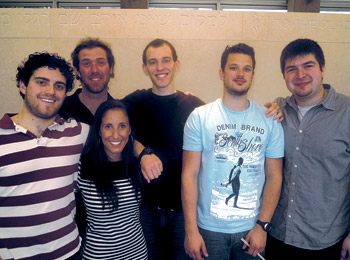VANCOUVER — When Warren Fingrut started medical school at the University of British Columbia last year, the 21-year-old Toronto student started inquiring about stem cell drives on campus.
“I’d been involved in stem cell drives in 2009 and 2010, while I was studying at McMaster,” he says. “That’s when I learned that all you had to do to join the registry of Canadian donors was to swab a cheek. So when I came to UBC, I started wondering why no one had organized a drive here.”
Recognizing the need for more drives, Fingrut founded a club in his medical school, called it Medical Students for Stem Cell Networks and recruited several of his colleagues to join. Then he partnered with Hillel, which has led bone marrow drives on other Canadian campuses, and organized three drives on the British Columbia campuses of UBC, the University of Victoria and Simon Fraser University.
“The Canadian stem cell registry is dreadfully low, and there are only 340,000 volunteer donors on its list,” he says. “Something like four per cent of Canadians donate blood regularly, but much fewer are on the stem cell donor registry. Our goal was to address this problem and improve the registry by signing up young donors. For people who need a stem cell or bone marrow transplant, this can save their lives.”
The students called their stem cell drive campaign “May The Swab Be With You” and at the drives, recruited students to swab their cheeks and fill out some paper work so that their genetic profile can be recorded. Once registered, a potential donor may be contacted to donate if someone in need of a bone-marrow graft with a matching genetic profile is found.
More than 900 Canadians with a blood cancer (lymphoma, leukemia, myeloma), autoimmune disease or bone-marrow infection are currently looking for a match but less than 30 per cent will find a match from within their family. A patient has the best chance of finding a match within their own ethnic group.
The three British Columbia drives succeeded in signing 686 students to OneMatch, the Canadian stem cell and bone marrow donor registry, a program of Canadian Blood Services. Next year, Fingrut plans to hold more drives in more locations and expects a much bigger yield.
“There’s no obligation to donate once you become a volunteer donor, but if there is a match for your stem cells, most of the time it’s just like a blood donation,” he says. The process of extracting stem cells is called apheresis and is no more painful than having an IV inserted into your arm.
One needle is inserted into each arm, pulling the stem cells from the body and separating them from the blood, which is returned to the donor. The process takes between four and six hours and the optimal population of donors is young, healthy men between the ages of 17 and 35. “Young, healthy male donors produce the rest results post-transplant,” says Cassandra DeLuca, OneMatch co-ordinator of donor management for Western Canada. “In general, results aren’t as good for women and for donors older than 35.”
Not everyone who joins the registry will be eligible to donate, but the idea is to get a well-rounded group of diverse donors who can be accessed if they are needed, she adds. For this reason, Fingrut’s initiative for the stem cell drive is invaluable. “Having young healthy males like Warren leading the charge and taking a strong leadership role in his own community – both his medical-student community and the broader
